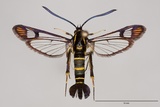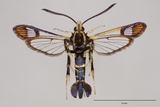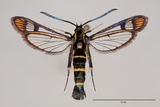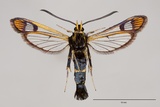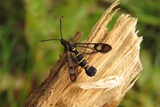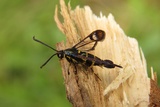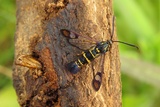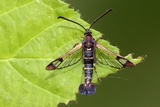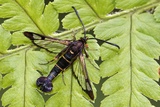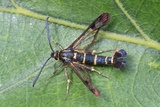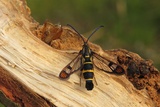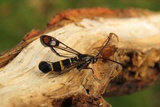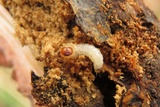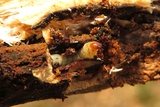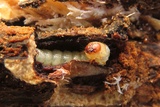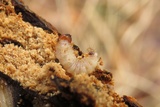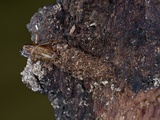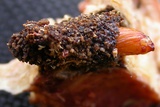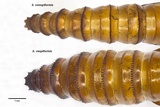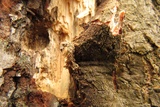Synanthedon conopiformis (Esper, 1782) Species
Last modified: July 3, 2022, 9:38 a.m.
This is a very rare species in Belgium and, at present, only known from LG, NA and LX.
Details
- Classification
- Family: Sesiidae > Subfamily: Sesiinae > Tribus: Synanthedonini > Genus: Synanthedon > Species: Synanthedon conopiformis
- Vernacular names
- Oranjetip-eikenwespvlinder (NL), Dale's Oak Clearwing (EN), Sésie du Chène (FR), Alteichen-Glasflügler (DE)
- Synonyms
- Synanthedon nomadaeformis (Laspeyres, 1801)
- First mention in Belgium
- De Sélys-Longchamps E. 1837. Catalogue des Lépidoptères ou Papillons de la Belgique, précédé du tableau des Libellulines de ce pays. — — : 1–29. On page 21 (as Sesia Nomadoeformis [sic]). view page
- Status
-
Native
Distribution
Imago
S. conopiformis is a size-variable species (15–25 mm) that is characterised by the square to trapezoidal yellow spot on the metathorax and the bright orange scales between the black veins at the apical area of the forewing. The anal tuft is completely black. The proboscis is, as in all species of this genus, well developed and functional.
The males are very well attracted to the pheromone originally developed for P. tabaniformis and are best lured from early evening till sunset but the optimal time span is very weather dependent.
Egg
The eggs are brown and elliptically shaped.
Mine
The caterpillars construct wide and flat mines that can be inhabited for many years by consecutive generations.
Cocoon/pupa
The cocoon is constructed from silk and small gnawed plant-particles and has a silken lining at the inside. The pupa itself is brown and can be easily distinguished from a pupa from S. vespiformis by the larger number of considerably smaller thorns at the last abdominal segments as compared to the latter species.
Bionomics
The female deposits the eggs in bark-crevices near damaged parts of the tree where there is an important build-up of callus tissue. This damage can be caused by forestry work but trees struck by lightning often appear to provide the ideal circumstances for the development of this species. Only old Quercus spp. trees are infested where it is important to notice that age –and not size– is the determining factor. The larva lives under the bark at the transition zone between the wood and this sap-rich callus parts and constructs flat and broad galleries that can be inhabited by consecutive generations, eventually creating a tangle of corridors. Often fine pale-yellow sawdust is ejected. The development includes two larval hibernations and the cocoon is constructed in spring after the second wintering.
The imagines are only active during daytime.
Flight periods
The adults fly from the end of May till the beginning of July.
Observed on
- Host plant (genera):
- Quercus
The larva bores between bark and wood of the trunk of old Quercus spp. trees. In this context, it is worth noting that it is not the size of the tree being a key factor but its age.
Habitat
Warm and dry, often sunny biotopes with old Quercus trees.
